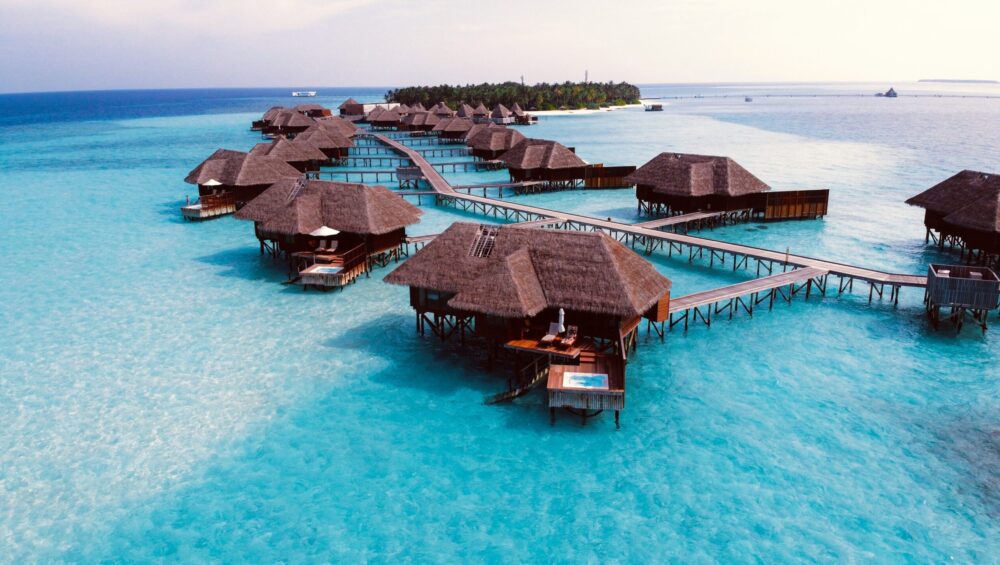The first thing you notice about the Maldives is the silence — a kind of quiet that isn’t empty, but full.
Waves whisper against white sand, palms sway like metronomes of time, and every breath feels cleaner, softer, slower.
Here, you learn the forgotten art of doing nothing — and doing it well.
The Maldives isn’t a single island, but a necklace of over a thousand coral isles scattered across the Indian Ocean. Some are wild and untouched, some hum with laughter and fishing boats, and others host a single luxurious resort hidden among palms.
Together, they create one of the most serene travel experiences on Earth — a place where sky and sea blur, and even the horizon seems to breathe.
Private Islands and Local Islands — Two Versions of Paradise
To understand the Maldives, you must understand its balance between private islands and local islands — two worlds connected by the same turquoise sea.
Private islands are the Maldives you see on postcards — overwater villas, infinity pools melting into the ocean, and breakfasts floating on blue glass. They are quiet, polished, perfect. Time seems to dissolve here, leaving only light and luxury.
Local islands, though, are where the country’s heart beats. The laughter of children, the clink of fishing nets, the sound of prayers at dusk.
Here, you trade champagne for coconut water, and curated silence for authentic simplicity.
Guesthouses line narrow sandy lanes, cafés serve mas huni (tuna and coconut salad) with hot tea, and locals greet you like you’ve always been part of their story.
Most travelers find their perfect rhythm in both — a few days of barefoot luxury followed by a few more of quiet authenticity. That’s the Maldives at its most real — elegant, but never detached.
When the Sky Meets the Sea — Best Time to Visit the Maldives
There is no wrong time to visit the Maldives — only different moods of the same masterpiece.
From December to April, skies stay clear, seas stay still, and sunlight paints the lagoons in impossible shades of blue. This is the best time to visit the Maldives for calm water, vibrant coral visibility, and long, lazy beach days.
From May to November, the islands breathe differently — greener, deeper, moodier.
Clouds drift in, rains pass quickly, and with the plankton blooms come the gentle giants: manta rays and whale sharks. The sea feels alive, full of movement and mystery.
Every season brings its own poetry — calm for rest, rain for reflection, and light for renewal.
Days That Flow Like Water — Things to Do in the Maldives
If you think “doing nothing” means being bored, the Maldives will prove you wrong.
Here, stillness comes with stories.
Spend your mornings snorkeling through coral gardens, where fish flash like confetti and turtles glide as if time doesn’t apply to them. Dive deeper, and you’ll find reef walls pulsing with color, manta rays circling cleaning stations like dancers in slow motion, and sometimes, if you’re lucky, the spotted giant — a whale shark passing by in silence.
Afternoons invite drift — kayaking across shallow lagoons, paddle-boarding under an open sky, or visiting a sandbank that appears only at low tide, a private island for a few fleeting hours.
At sunset, the sea turns to liquid gold. You might sail out for a dolphin cruise, or simply lie back on a deck and watch as stars spill into the ocean’s reflection.
And when night finally arrives, you realize that darkness here glows — sometimes literally.
Walk along the shore on the right night, and the sea glitters with bioluminescent plankton, tiny sparks lighting up your footprints. It’s one of nature’s quiet miracles — something no resort can manufacture, and no photograph can truly capture.
Life on Land — The Culture of the Islands
Beyond the beaches and reefs, the Maldives carries a deep cultural heartbeat.
It’s a Muslim nation, warm and welcoming, where modesty and respect shape daily life.
On local islands, you’ll hear the call to prayer mingling with the sound of the sea. Women sell sweet coconuts from woven baskets, and children play barefoot on sandy streets that double as playgrounds.
Every island has a story — of sailors, storms, and centuries of trade between Africa, Arabia, and Asia.
You’ll find traces of those influences in everything: the architecture, the songs, the food.
This is why visiting a local island isn’t just a budget choice — it’s a richer one. You don’t just see paradise; you live in it, even if for a while.
Flavors That Taste Like Sunshine
Maldivian food is a mirror of its life — simple, warm, full of the sea.
Breakfast usually means mas huni — tuna, coconut, onion, and lime mixed together and wrapped in soft roshi bread.
Lunch might be a mild fish curry with rice, pickles, and chili sambol.
Evenings bring hedhikaa — golden fried snacks like bajiya (tuna pastry) and gulha (tiny fish dumplings) shared with friends over sweet black tea.
If you stay on a local island, meals are homemade, heart-filled, and generous.
On private islands, the same flavors get dressed up — plated beautifully but still carrying the same coastal soul.
Either way, you’ll taste something you can’t quite name — freshness, yes, but also honesty.
Adventure Beneath the Calm
Even peace has its wild side here.
For divers, the Maldives is a living aquarium — coral walls, drift dives through channels filled with reef sharks, caves lit by sunlight beams, and manta rays gliding so close you can hear the water move around them.
If you’re not into diving, you’ll still find plenty to fall in love with — night snorkeling, kayaking under moonlight, or even just floating on a sandbank while the tide hums a lullaby.
Adventure in the Maldives isn’t about adrenaline. It’s about intimacy — the feeling of being small in the vastness of something perfect.
Where the Sky Sleeps in the Water
Sunsets in the Maldives don’t rush. They stretch. The colors bloom slowly — gold to rose to violet — until even the clouds look painted.
Couples often say it feels like the whole sky pauses for them.
Families linger on the sand, kids building castles in the last light.
Travelers sit quietly with coffee, realizing that silence can be the purest kind of happiness.
This is why the Maldives has become one of the best honeymoon destinations in the world not for luxury, but for peace. It gives you space to be with someone, or with yourself, without noise.
When to Go, What to Pack, How to Stay
The best time to visit the Maldives depends on what you seek —
calm seas (December–April), marine life (May–November), or simply a good excuse to disappear.
Getting here is easy — flights from India and across the world land in Malé, from where speedboats, ferries, and seaplanes scatter travelers across the atolls like pearls.
Each ride feels like a prelude — an entry into a watercolor world.
There’s no need to overpack — light clothes, reef-safe sunscreen, a hat, and curiosity.
Luxury is easy to buy here, but wonder is free.
Most travelers come to the Maldives expecting paradise. They leave with something gentler — gratitude. Gratitude for the quiet, for the colors, for the reminder that life doesn’t have to move so fast.
The Maldives don’t demand adventure or perfection. It offers peace — clear, simple, and endless. Whether you stay in a villa above water or a guesthouse by a village beach, what stays with you is the feeling that the ocean has taught you something essential — how to be still, and still be alive.
World Tours curates Maldives experiences that balance the heart of travel — connection, beauty, and breath.
We don’t sell you a resort; we help you find your rhythm.







